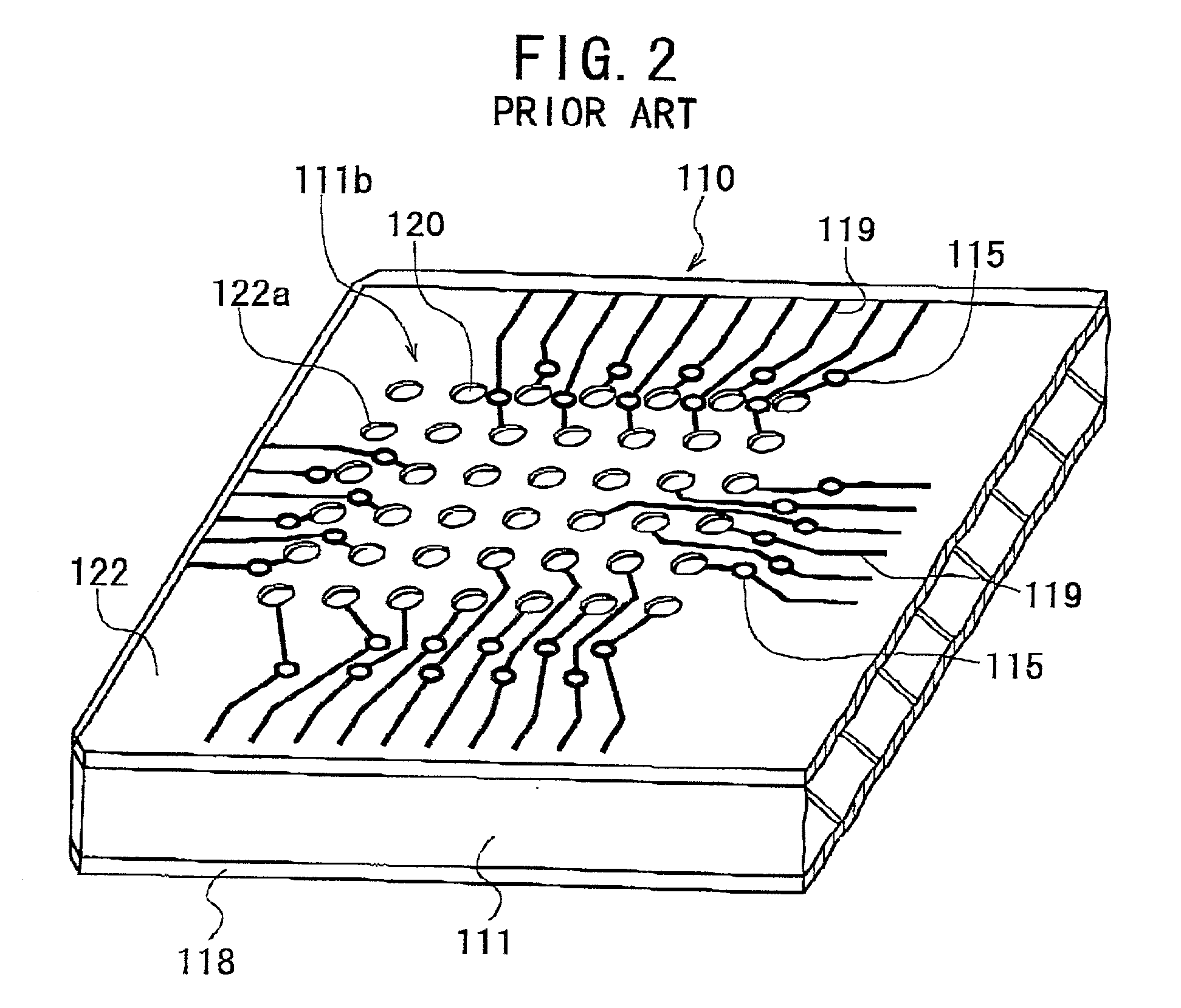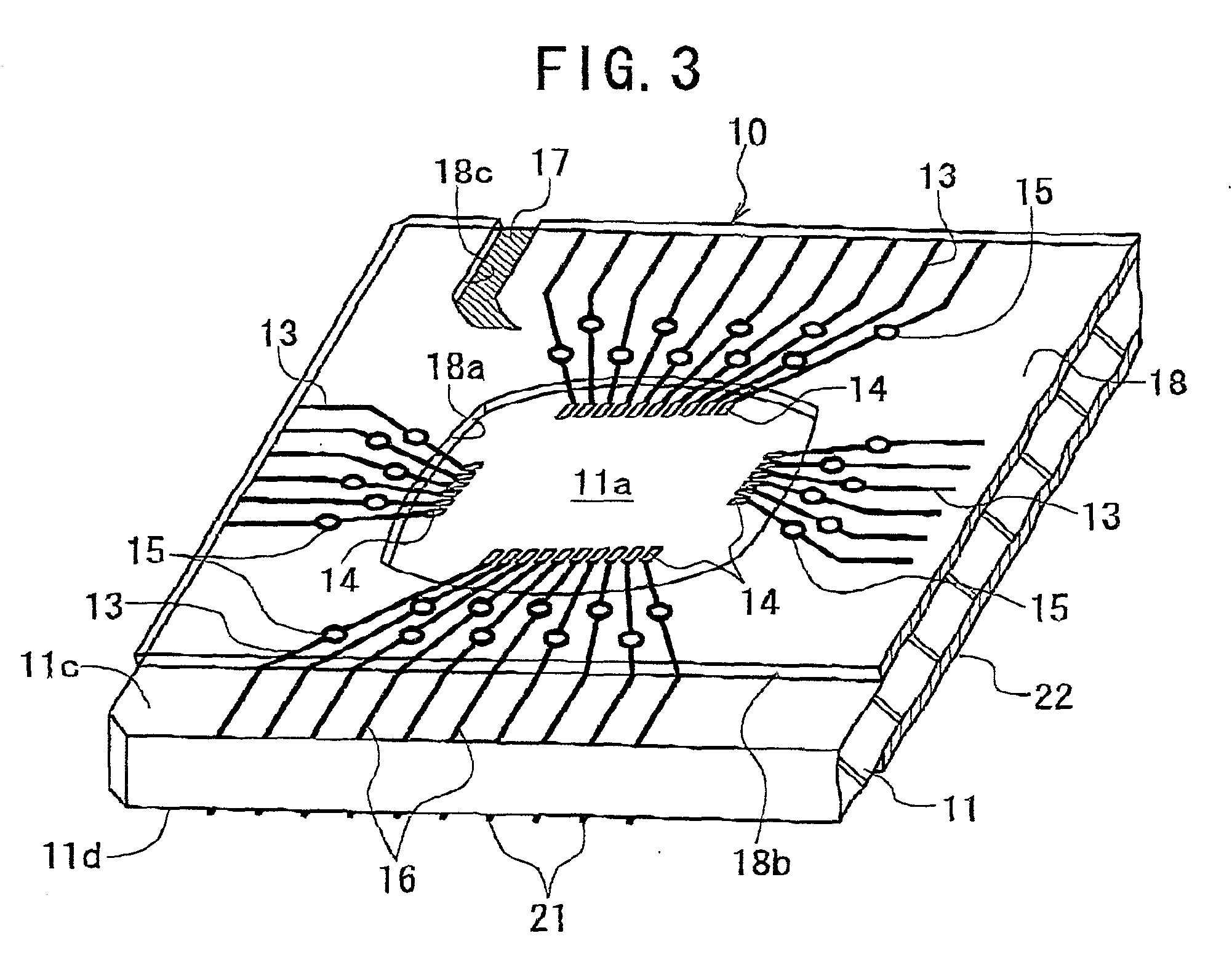Substrate for semiconductor device and semiconductor device fabrication using the same
- Summary
- Abstract
- Description
- Claims
- Application Information
AI Technical Summary
Problems solved by technology
Method used
Image
Examples
first embodiment
[0103] A substrate for a semiconductor device according to the invention is shown in FIGS. 3 to 6.
[0104] As shown in FIGS. 3 to 6, the substrate 10 according to the first embodiment comprises a rectangular plate-shaped, rigid dielectric core material 11 having an upper surface and a lower surface. As seen from FIGS. 5 and 6, the core material 11 is strip-shaped and has four mounting areas 11a on its upper surface and four land areas 11b on its lower surface. The areas 11a and 11b are arranged at equal intervals along the longitudinal axis of the care material 11. The core material 11 is typically made of a proper dielectric material, such as woven glass cloth impregnated with epoxy resin.
[0105] A semiconductor element or an IC chip 23 is mounted in each mounting area 11a in a later process, as shown in FIGS. 7 and 8. Lands 20 as external terminals are arranged in the form of array in each land area 11b, as shown in FIG. 4.
[0106] A patterned conductive layer is formed on the upper su...
second embodiment
[0128] FIG. 10 shows the configuration of a semiconductor substrate 10A according to a second embodiment of the invention.
[0129] In the above-described substrate 10 according to the first embodiment, the solder resist layer 18 does not cover the mounting areas 11a of the core material 11 in which the semiconductor elements 23 are respectively mounted. However, the invention is not limited to this structure. It is needless to say the solder resist layer 18 is formed to cover each mounting area 11a, as shown by the substrate 11A of the second embodiment.
[0130] As shown in FIG. 10, the substrate 10A comprises the same configuration as the substrate 10 of the first embodiment as shown in FIGS. 3 to 6, except that additional inner wiring lines 13a are provided, and that windows 26a and 26b are provided in the solder resist layer 18. Therefore, the detailed description about the same configuration is omitted here for the sake of simplification of description by attaching the same referenc...
third embodiment
[0136] FIG. 11 shows the configuration of a semiconductor substrate 10B according to a third embodiment of the invention. In this embodiment, the upper and lower contact areas 11c and 11d provided in the first and second embodiments are eliminated and thus, no part protruding laterally from the solder resist layers 18 and 22. Instead, plated "dummy" through holes 27 are formed on the side face 11e of the core material 11. The side face 11a serves as a contact area. Unlike the first and second embodiments, the width of the solder resist layers 18 and 22 are equal to that of the core material 11. The other configuration is the same as the substrate 10 according to the first embodiment.
[0137] The holes 27, which have the same semicircular cross section, are formed on the vertical side face 11e of the core material 11. Part of the inner wiring lines 13 on the upper surface of the core material 11 are mechanically and electrically connected to the inner wiring lines 21 on the lower surfa...
PUM
 Login to View More
Login to View More Abstract
Description
Claims
Application Information
 Login to View More
Login to View More - R&D Engineer
- R&D Manager
- IP Professional
- Industry Leading Data Capabilities
- Powerful AI technology
- Patent DNA Extraction
Browse by: Latest US Patents, China's latest patents, Technical Efficacy Thesaurus, Application Domain, Technology Topic, Popular Technical Reports.
© 2024 PatSnap. All rights reserved.Legal|Privacy policy|Modern Slavery Act Transparency Statement|Sitemap|About US| Contact US: help@patsnap.com










